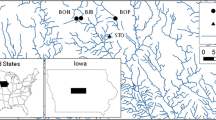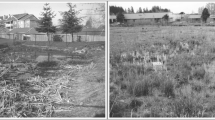Abstract
Anthropogenic land use is known to impact aquatic ecosystems in several ways, including increased frequency and intensity of floods, stream channel incision, sedimentation, and loss of microtopography. Amphibians are susceptible to changes in wetland and surrounding habitats. This study evaluated amphibian assemblages of fifteen headwater slope wetlands in coastal Alabama across a gradient of land uses. Amphibians were surveyed on a seasonal basis and land use was delineated within wetland watersheds and within a 200-m buffer surrounding each wetland. Amphibian presence/absence and land use data were used to develop species occupancy models. Both urban and agricultural land use were shown to influence amphibian occurrence. Species richness ranged from five to ten species across sites; however, five species only occurred in wetlands surrounded by forested lands. Many species were detected more frequently on these wetlands compared to wetlands surrounded by urban or mixed land uses. Occupancy models showed Acris gryllus was negatively associated with the amount of agriculture within a buffer around the wetland. Hyla squirella, Lithobates clamitans, and L. sphenocephalus were positively associated with agricultural land within a watershed. Anaxyrus terrestris and the non-native Eleutherodactylus planirostris were positively associated with the amount of impervious surface area within the wetland buffer.

Similar content being viewed by others
References
Alford RA, Richards SJ (1999) Global amphibian declines: a problem in applied ecology. Annu Rev Ecol Syst 30:133–165
Anderson JR, Hardy EE, Roach JT, Witmer RE (1976) A land use and land cover classification system for use with remote sensor data. Geological Survey Professional Paper 964
Barksdale WF, Anderson CJ, Kalin L (2014) The influence of watershed run-off on the hydrology, forest floor litter and soil carbon of headwater wetlands. Ecohydrol 7(2):803–814
Barrett K, Guyer C (2008) Differential responses of amphibians and reptiles in riparian and stream habitats to land use disturbances in western Georgia, USA. Biol Conserv 141(9):2290–2300
Barrett K, Helms BS, Samoray ST, Guyer C (2010) Growth patterns of a stream vertebrate differ between urban and forested catchments. Freshw Biol 55(8):1628–1635
Beebee TJC (1983) Habitat selection by amphibians across an agricultural land-heathland transect in Britain. Biol Conserv 27:111–124
Blann KL, Anderson JL, Sands GR, Vondracek B (2009) Effects of agricultural drainage on aquatic ecosystems: a review. Crit Rev Environ Sci Technol 39:909–1001
Blaustein AR, Belden LK, Olson DH, Green DM, Root TL, Kiesecker JM (2001) Amphibian breeding and climate change. Conserv Biol 15:1804–1809
Boone MD, Semlitsch RD, Little EE, Doyle MC (2007) Multiple stressors in amphibian communities: effects of chemical contamination, bullfrogs, and fish. Ecol Appl 17:291–301
Brand AB, Snodgrass JW, Gallagher MT, Casey RE, Van Meter R (2010) Lethal and sublethal effects of embryonic and larval exposure of Hyla versicolor to stormwater pond sediments. Arch Environ Contam Toxicol 58:325–331
Bridges CM, Semlitsch RD (2000) Variation in pesticide tolerance of tadpoles among and within species of Ranidae and patterns of amphibian decline. Conserv Biol 14:1490–1499
Carey SD (1982) Geographic distribution: Eleutherodactylus planirostris planirostris. Herpetological Review 13:130
Collins JP, Storfer A (2003) Global amphibian declines: sorting the hypotheses. Divers Distrib 9:89–98
Collins SJ, Russell RW (2009) Toxicity of road salt to Nova Scotia amphibians. Environ Pollut 157:320–324
Delis PR, Mushinsky HR, McCoy ED (1996) Decline of some west-central Florida anuran populations in response to habitat degradation. Biodivers Conserv 5:1579–1595
Gibbons JW (2003) Terrestrial habitat: a vital component for herpetofauna of isolated wetlands. Wetlands 23:630–635
Gibbs J (1998) Distribution of woodland amphibians along a forest fragmentation gradient. Landsc Ecol 13:263–268
Gotelli NJ, Colwell RK (2001) Quantifying biodiversity: procedures and pitfalls in the measurement and comparison of species richness. Ecol Lett 4:379–391
Guerry AD, Hunter ML Jr (2002) Amphibian distributions in a landscape of forests and agriculture: an examination of landscape composition and configuration. Conserv Biol 16:745–754
Hines JE (2006) PRESENCE2- Software to estimate patch occupancy and related parameters. USGS-PWRC. http://www.mbr-pwrc.usgs.gov/software/presence.html.
Herrmann HL, Babbitt KJ, Baber MJ, Congalton RG (2005) Effects of landscape characteristics on amphibian distribution in a forest-dominated landscape. Biol Conserv 123:139–149
Houlahan JE, Findlay CS (2003) The effects of adjacent land use on wetland amphibian species richness and community composition. Can J Fish Aquat Sci 60:1078–1094
Jaeger RG (1971) Competitive exclusion as a factor influencing the distributions of two species of terrestrial salamanders. Ecology 52:632–637
Jensen JB (2005) Acris gryllus (LeConte, 1825) Southern Cricket Frog. In: Lannoo M (ed) Amphibian Declines: The Conservation Status of United States Species. University of California Press, Berkeley, p 1094
Johnson PT, McKenzie VJ, Peterson AC, Kerby JL, Brown J, Blaustein AR, Jackson T (2011) Regional decline of an iconic amphibian associated with elevation, land-use change, and invasive species. Conserv Biol 25:556–566
Knutson MG, Sauer JR, Olsen DA, Mossman MJ, Hemesath LM, Lannoo MJ (1999) Effects of landscape composition and wetland fragmentation on frog and toad abundance and species richness in Iowa and Wisconsin, U.S.A. Conserv Biol 13:1437–1446
Kraus F, Campbell EW, Allison A, Pratt T (1999) Eleutherodactylus frog introductions to Hawaii. Herpetological Review 30:21–25
MacKenzie DI, Nichols JD, Lachman GB, Droege S, Royle JA, Langtimm CA (2002) Estimating site occupancy rates when detection probabilities are less than one. Ecology 83:2248–2255
MacKenzie DI, Nichols JD, Royle JA, Pollock KH, Bailey LL, Hines JE (2006) Occupancy Estimation and Modeling: Inferring Patterns and Dynamics of Species Occurrence. Academic Press Elsevier, Burlington, p 324
Mitchell JC, Lannoo MJ (2005) Hyla squirella Bosc, 1800 Squirrel Treefrog. In: Lannoo M (ed) Amphibian Declines: The Conservation Status of United States Species. University of California Press, Berkeley, p 1094
Mount RH (1975) The Reptiles and Amphibians of Alabama. The University of Alabama Press, Tuscaloosa, p 347
National Oceanic and Atmospheric Administration (2013) National Climatic Data Center. Weekly Palmer Drought Indices. http://www.ncdc.noaa.gov/temp-and-precip/drought/weekly-palmers.php
Noble CV, Wakeley JS, Roberts TH, Henderson C (2007) Regional guidebook for applying the hydrogeomorphic approach to assessing the functions of headwater slope wetlands on the Mississippi and Alabama Coastal Plains
Pauley TK, Watson MB (2005) Eurycea cirrigera (Green, 1830) Southern Two-lined Salamander. In: Lannoo M (ed) Amphibian Declines: The Conservation Status of United States Species. University of California Press, Berkeley, p 1094
Porej D, Micacchion M, Hetherington TE (2004) Core terrestrial habitat for conservation of local populations of salamanders and wood frogs in agricultural landscapes. Biol Conserv 120:399–409
R Core Team. 2013. R: A Language and Environment for Statistical Computing. R Foundation for Statistical Computing. http://www.R-project.org
Schoonover JE, Lockaby BG, Helms BS (2006) Impacts of land cover on stream hydrology in the West Georgia Piedmont, USA. J Environ Qual 35:2123–2131
Scott DE, Metts BS, Gibbons JW (2003) Seasonal wetlands and golf courses. Golf Course Management 85–89
Semlitsch R (1997) Biological delineation of terrestrial buffer zones for pond-breeding salamanders. Conserv Biol 12:1113–1119
Skelly DK, Freidenburg LK, Kiesecker JM (2002) Forest canopy and the performance of larval amphibians. Ecology 83:983–992
Snodgrass JW, Casey RE, Joseph D, Simon JA (2008) Microcosm investigations of stormwater pond sediment toxicity to embryonic and larval amphibians: variation in sensitivity among species. Environ Pollut 154:291–297
Todd BD, Luhring TM, Rothermel BB, Gibbons JW (2009) Effects of forest removal on amphibian migrations: implications for habitat and landscape connectivity. J Appl Ecol 46:554–561
U.S. Census Bureau (2010) http://2010.census.gov/2010censusdata/
U.S. Department of Agriculture (2009) 2007 Census of Agriculture. Service, National Agricultural Statistics
Walls SC, Barichivich WJ, Brown ME, Scott DE, Hossack BR (2013) Influence of drought on salamander occupancy of isolated wetlands on the southeastern Coastal Plain of the United States. Wetlands 33:345–354
Walsh CJ, Roy AH, Feminella JW, Cottingham PD, Groffman PM, Morgan RP II (2005) The urban stream syndrome: current knowledge and the search for a cure. The North American Benthological Society 24:706–723
Wang L, Seelbach PW, Hughes RM (2006) Introduction to landscape influences on stream habitats and biological assemblages. Am Fish Soc Symp 48:1–23
Welsh HH Jr, Droege S (2001) A case for using Plethodontid salamanders for monitoring biodiversity and ecosystem integrity of North American forests. Conserv Biol 15:558–569
Wilson LD, Porras L (1983) The Ecological Impact of Man on the South Florida Herpetofauna. Allen Press, Inc., Lawrence, p 89
Acknowledgments
An Alabama Agricultural Experiment Station Hatch Grant and the Auburn University Center for Forest Sustainability provided funding for this project. The USGS Alabama Cooperative Fish and Wildlife Research Unit provided equipment. Flynt Barksdale, Betsy Battistella, Cody Cox, Mignon Denton, Amber Dunn, the Guyer Lab, Tom Hess, Heather Hughes, Scott Phipps, Christina Romagosa, Brad Schneid, Amir Sharifi, Amy Silvano, Todd Steury, and Madeline Wedge all provided assistance on this project. We graciously acknowledge land access that was granted by Alabama State Parks, The City of Foley, The Nature Conservancy, Town of Robertsdale, Weeks Bay National Estuarine Research Reserve, and many private landowners. An earlier version of this manuscript was greatly improved by the review and suggestions of Robert Gitzen. Any use of trade, firm, or product names is for descriptive purposes only and does not imply endorsement by the U.S. Government. This study was performed under the auspices of Auburn University IACUC protocol # 2010–1827.
Author information
Authors and Affiliations
Corresponding author
Rights and permissions
About this article
Cite this article
Alix, D.M., Anderson, C.J., Grand, J.B. et al. Evaluating the Effects of Land Use on Headwater Wetland Amphibian Assemblages in Coastal Alabama. Wetlands 34, 917–926 (2014). https://doi.org/10.1007/s13157-014-0553-y
Received:
Accepted:
Published:
Issue Date:
DOI: https://doi.org/10.1007/s13157-014-0553-y




